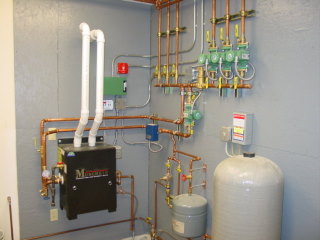We serve Warren, Washington and Saratoga Counties, New York
What’s the difference between a condensing and non-condensing boiler? (And which one is best for you?)
Because of the reduction in fuel costs when using condensing boilers, legislation in European countries has banned the use of non-condensing boilers for replacements in existing homes, and also in new construction.
Not so in the United States and Canada. This puts more responsibility on the North American homeowner to research the facts, screen their heating contractor, and protect themselves from high heating bills.
Standard boilers that your grandparents had (and are still being sold in the U.S.A. today—scary!) are non-condensing. A non-condensing boiler’s typical efficiency falls in the range of about 75-85%. Condensing boilers’ efficiency ranges are 90-95%.
Why can’t you buy a boiler that’s 100% efficient?
100% efficiency is not possible with any burning appliance.
This is mainly due to the fact that products of combustion (exhaust) carry away some of the heat given off by the burning fuel, dumping that heat into the atmosphere.
What makes condensing boilers so efficient?
A condensing boiler for your home is more efficient because in short, more of the heat from the flame will be absorbed by the boiler water.
So more of your hard earned dollars are used to heat your home, instead of literally going up the chimney, and being lost to the great outdoors.
How does it work?
The answer gets a little technical, so please hang on while I explain.
Understanding these basic principles can save you a lot of money on your fuel bills, and make sure you stay comfortable in your home, even on the coldest days of the year.
- The boiler takes the heat from the fuel it’s burning
- The heat is pushed through the primary heat exchanger, giving up some of its energy into the water that runs to the hot water baseboards, radiators, and/or radiant floor tubing
- The combustion gases, or exhausts, are then re-routed and diverted over a secondary heat exchanger, which extracts more energy
- This cools the exhaust temperature to around 130 degrees F
- The much cooler exhaust turns into liquid (condensate, thus the “condensing boiler” label) as it contacts the secondary heat exchanger surface.
- This exhaust cooling process means latent energy is captured and diverted back into your heating system
- The liquid that formed turns into droplets, which fall by gravity to collect and drain
- The much-lower-in-temperature leftover exhaust is blown outside with a fan
The Benefit:
When the exhaust turns into liquid and gives up its latent energy, it adds to the efficiency rating of the boiler.
The 10-15% increased efficiency means the boiler uses less fuel, costs less to run, and helps us to be less dependent on foreign energy sources.
If they’re so great, why aren’t all boilers sold in the U.S.A. condensing?
Two words: manufacturing costs.
- The liquid exhaust, the condensate, has to be safely removed from the boiler. To include this into the design requires the use of stainless steel or aluminum. (Rather than the cast iron or steel used in the non-condensing boiler)
- The natural buoyancy of the exhaust is lost when the temperature is brought this low, so it is necessary to have a fan to remove it
- For a boiler to cool the exhaust as much as it does, it has to have a larger, more efficient heat exchanger than traditional boilers
- All the above materials: superior metals, an extra fan, and a larger heat exchanger, cost more
The Condensing Boiler Catch-22
The paradox is that the often old-fashioned know-how of a typical plumber may not match the superior efficiencies of the state-of-the-art condensing boiler.
As a result, you may find some difficulty locating a designer and installer capable of doing the work to your satisfaction. For the same reason you may find problems locating plumbers who are capable of repairs on these boilers.

It takes a systems approach by a skilled and experienced heating technician to ensure that you’ll be able to save more in reduced fuel bills than you spend on the extra cost of the condensing boiler.
For example, it’s only possible for a condensing boiler to work to these very high efficiencies if the boiler’s return water temperature is kept below 130 degrees F.
But if your heating system uses hot water baseboards or radiators, water return temperatures will typically be around 160-180 degrees F.
Running hot water baseboard or radiator systems cooler than this could damage the non-condensing boiler, and/or make it difficult to keep your home warm on the coldest day of the year.
Buyer Beware
The resulting irony is that homeowners who are installing condensing boilers in homes with hot water baseboards or radiators are under the impression they’re getting more for their money.
But the essential low operating temperatures have not been achieved. So they’re saving a little, but not getting the vast savings they’re led to expect.
Your expert heating contractor’s comprehensive heat loss calculations will assess whether your radiators or baseboards will be able to keep you comfortable with the lower 130 degree return water temperatures.
And he’ll likely incorporate outdoor reset controls to address the challenge of lower operating temperatures.
(Side note: Using a condensing boiler with radiant floors instead of radiators or baseboard, will meet this low temperature requirement. Another case for radiant floor heating’s superior efficiency.)